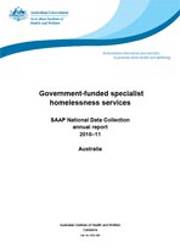Summary
Homelessness can affect anyone in the community. Each year many Australians either experience homelessness or find themselves in circumstances that put them at risk of becoming homeless. In response to this, Australian governments fund a range of services specifically designed to reduce the incidence or frequency of homelessness and the impact it has on people and families. These services are known as specialist homelessness services and are largely delivered by non-government organisations.
This report presents the 2010–11 data on the use of government-funded specialist homelessness services (see Box 1.1). It is the final annual report to be sourced from the Supported Accommodation Assistance Program (SAAP) National Data Collection (NDC). From 1 July 2011, data on the people using specialist homelessness services will be reported from the new Specialist Homelessness Services (SHS) collection.
In 2010–11, an estimated 230,500 people (equivalent to 1 in 97 Australians) used specialist homelessness services. Of these, 142,500 (62%) were clients and 88,000 (38%) were children accompanying clients (see Box 3.1).
The people supported by specialist homelessness agencies come from diverse sections of the community—with young people, families, and Aboriginal and Torres Strait Islander people continuing to be significant service users in 2010–11. As such, it is not surprising that people's reasons for seeking assistance and their requirements in relation to support vary. In 2010–11:
- unaccompanied women, females with children and young people commonly sought assistance because of issues in their interpersonal relationships, such as domestic or family violence or the breakdown of a relationship with a family member, spouse or partner
- unaccompanied men aged 25 and over commonly sought assistance because of drug, alcohol or substance use or as a result of financial difficulties
- couples, both with and without children, and males with children commonly sought assistance because of accommodation-related issues, such as being evicted.
With the exception of a small increase in the average age of clients, there has been little change in recent years in the overall demographic profile of clients and their accompanying children, their reasons for seeking assistance, or in their circumstances immediately following support. There have, however, been some changes in the use of government-funded specialist homelessness services. From 2006–07 to 2010–11 there has been:
- a small increase in the overall rate of Australians using specialist homelessness services—from 1 in every 110 to 1 in every 97
- a decrease in the proportion of support periods that included a period of specialist homelessness accommodation—from 38% to 27%
- an increase in the overall length of support and accommodation—support from an average of 50 days to 68 days; and accommodation from an average of 50 days to 65 days.



